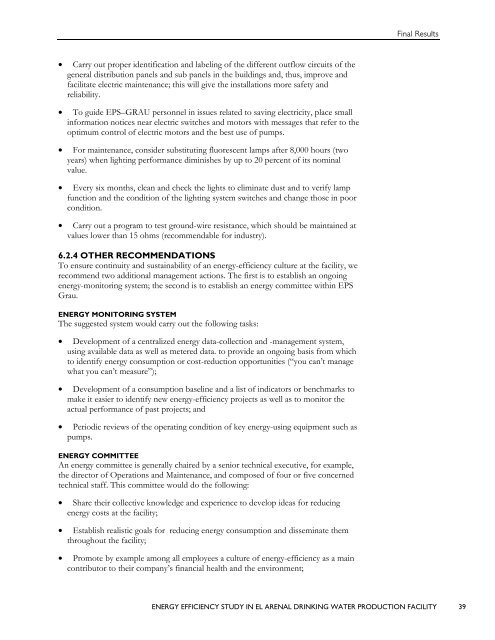Electrical - usaid
Electrical - usaid
Electrical - usaid
Create successful ePaper yourself
Turn your PDF publications into a flip-book with our unique Google optimized e-Paper software.
• Carry out proper identification and labeling of the different outflow circuits of the<br />
general distribution panels and sub panels in the buildings and, thus, improve and<br />
facilitate electric maintenance; this will give the installations more safety and<br />
reliability.<br />
• To guide EPS–GRAU personnel in issues related to saving electricity, place small<br />
information notices near electric switches and motors with messages that refer to the<br />
optimum control of electric motors and the best use of pumps.<br />
• For maintenance, consider substituting fluorescent lamps after 8,000 hours (two<br />
years) when lighting performance diminishes by up to 20 percent of its nominal<br />
value.<br />
• Every six months, clean and check the lights to eliminate dust and to verify lamp<br />
function and the condition of the lighting system switches and change those in poor<br />
condition.<br />
• Carry out a program to test ground-wire resistance, which should be maintained at<br />
values lower than 15 ohms (recommendable for industry).<br />
6.2.4 OTHER RECOMMENDATIONS<br />
To ensure continuity and sustainability of an energy-efficiency culture at the facility, we<br />
recommend two additional management actions. The first is to establish an ongoing<br />
energy-monitoring system; the second is to establish an energy committee within EPS<br />
Grau.<br />
ENERGY MONITORING SYSTEM<br />
The suggested system would carry out the following tasks:<br />
• Development of a centralized energy data-collection and -management system,<br />
using available data as well as metered data. to provide an ongoing basis from which<br />
to identify energy consumption or cost-reduction opportunities (“you can’t manage<br />
what you can’t measure”);<br />
• Development of a consumption baseline and a list of indicators or benchmarks to<br />
make it easier to identify new energy-efficiency projects as well as to monitor the<br />
actual performance of past projects; and<br />
• Periodic reviews of the operating condition of key energy-using equipment such as<br />
pumps.<br />
ENERGY COMMITTEE<br />
An energy committee is generally chaired by a senior technical executive, for example,<br />
the director of Operations and Maintenance, and composed of four or five concerned<br />
technical staff. This committee would do the following:<br />
• Share their collective knowledge and experience to develop ideas for reducing<br />
energy costs at the facility;<br />
• Establish realistic goals for reducing energy consumption and disseminate them<br />
throughout the facility;<br />
• Promote by example among all employees a culture of energy-efficiency as a main<br />
contributor to their company’s financial health and the environment;<br />
Final Results<br />
ENERGY EFFICIENCY STUDY IN EL ARENAL DRINKING WATER PRODUCTION FACILITY 39

















